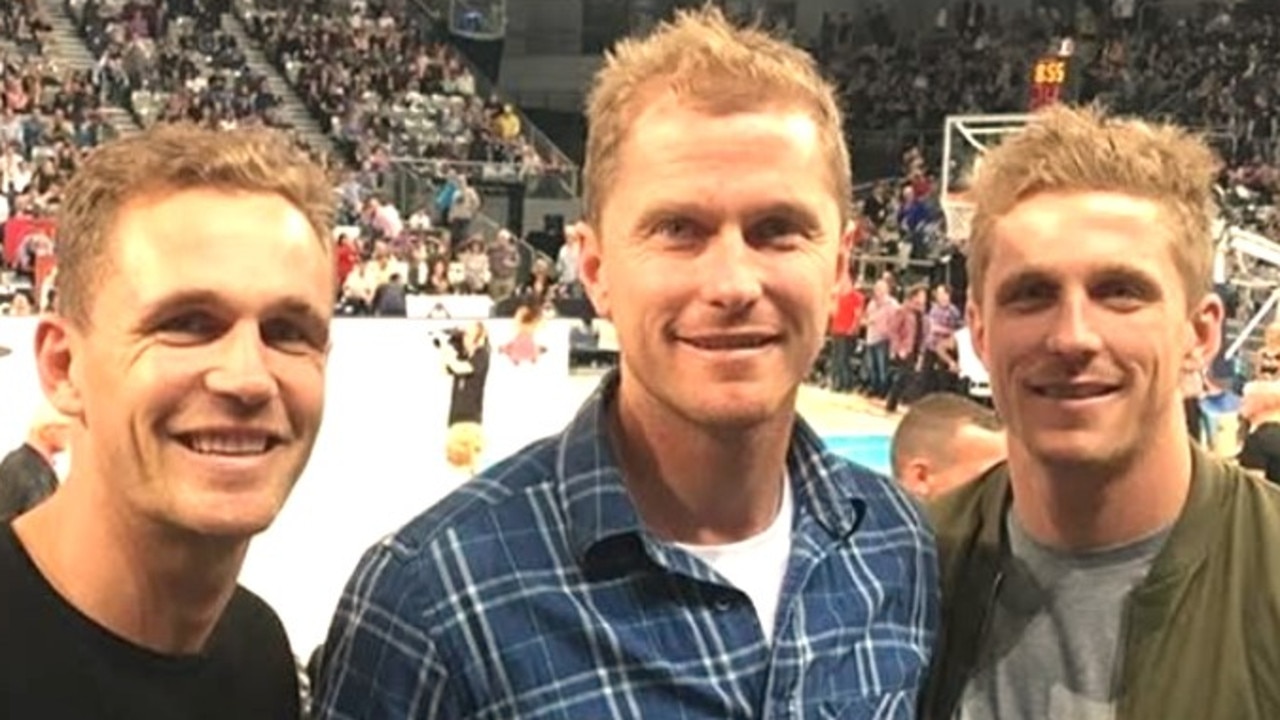Inside the rise of Tassie: Locals thought Gillon McLachlan wanted to move Roos, but now 19th team a reality
The passion for footy in Tasmania was clear, yet the sport was dying somehow before one gala dinner helped set in motion events that would give Tasmania its own AFL team.
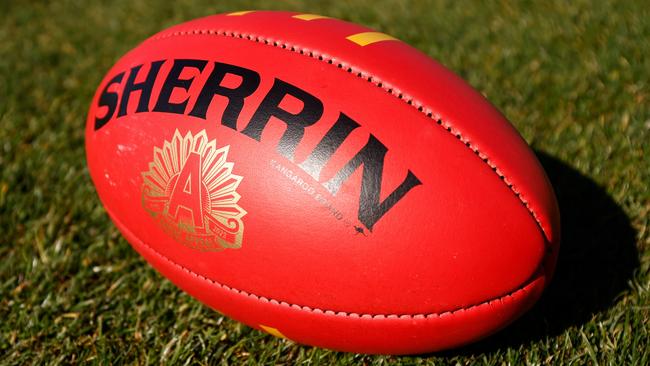
AFL
Don't miss out on the headlines from AFL. Followed categories will be added to My News.
The passion in the air was obvious. They were all in the room for one reason, their love for Tasmanian football and the fact it was dying.
It was a cold autumn night in the middle of May, 2017, in Melbourne when 500 diehard fans of football in the Apple Isle came together for a Gala dinner which in many ways was essentially a last roll of the dice.
Grassroots football in the state was on its knees and a foundation had been set up by AFL Tasmania chief executive Rob Auld to try and raise awareness, and more importantly, funds to save the game.
There were AFL legends everywhere. Peter Hudson presented the narrative, Triple Brownlow Medallist Ian Stewart made a rare public appearance, Matthew Richardson provided a keynote speech while the last Robert Shaw-coached state team to have defeated Victoria, which included the likes of Brendon Gale, Graham Wright and Scott Clayton were presented on stage.
Alastair Lynch was doing the interviews with current day superstars from Tasmania, Nick and Jack Riewoldt, speaking about their love for their home state. Gold Coast Suns coach Rodney Eade was on a panel alongside Carlton coach Brendon Bolton and new Brisbane coach Chris Fagan.
“The AFL won’t truly be complete until there is a Tasmanian team,” Fagan told the gathering which included members of the AFL Commission and league CEO Gillon McLachlan.
There had been a number of failed bids to get a Tasmania team into the AFL dating back to 1994 when Ross Oakley was presented with a report which included a 30,000 seat stadium at the Hobart Showgrounds.
In 2008 a delegation led by MP Paula Wriedt launched a bid carrying the slogan “It’s time”. They met with the AFL but were quickly sent packing.
There had never been enough substance behind the pushes and there had certainly never been the public show of force like what was seen on that night at Crown Casino.
It was hard not to get carried away with the emotion and for many in the room they knew it was a significant moment in time as it put Tasmanian football back on the radar.
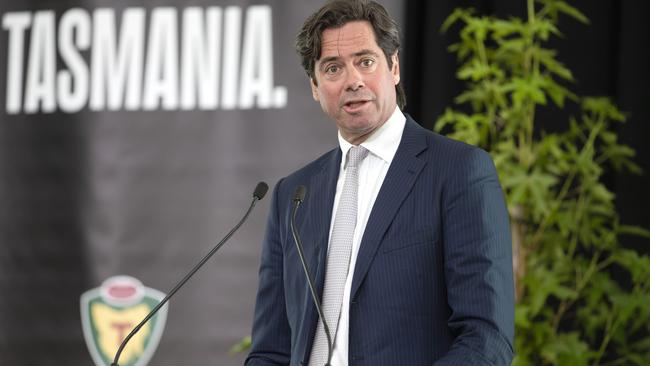
RELOCATE A BASKET CASE OR INTRODUCE A 19TH TEAM?
The general feeling among Tasmania football people was that Gillon McLachlan wanted to pick North Melbourne up and dump them down in Tassie.
That would solve the AFL boss a lot of problems. The Kangaroos were a basket case, on and off the field, and this yearning for a 19th team in Tasmania was constantly gnawing away in the background.
While Hawthorn had been the trailblazer in Tasmania, making Launceston its second home, the Kangaroos were playing games in Hobart so a lot of the heavy lifting had already been done.
But this time the noise coming out of Tasmania was different. The momentum from the Gala dinner was real and in June 2019 a task force was set up to submit a fresh bid.
Former St Kilda champion Nick Riewoldt was the obvious public face and spruiker for the task force.
“Tasmania have the opportunity and the strength to stand up on their own two feet. I don’t know why a 19th team wouldn’t be a realistic possibility,” he said.
“I genuinely believe Tassie would be an addition to the game, not a drain as some people have proposed.”
The task force team included former Woolworths CEO Grant O’Brien, local Lauderdale Football Club president Julie Kay, prominent Tasmanian business identity Errol Stewart, former GWS Giants Chief Financial Officer and TasRacing CEO, Paul Eriksson, and high-profile sports agent James Henderson who managed Tasmania’s favourite son, former Australian Test captain Ricky Ponting.
But the key to it all was the chairman, Brett Godfrey. He was the founding Virgin Australia CEO who brought serious business cred to the table and he wasn’t even Tasmanian. In fact, he wasn’t even an AFL follower, he preferred rugby.
“The issue was the chairman, how do you find the right chairman to get the Commission’s attention?” Henderson said.
“He was able to stand up and say, ‘Hey, I’m not Tasmanian, I’m actually a rugby guy but I’m passionate about this. I’ve got investments in Tassie, I run businesses in Tassie and Tassie deserves this chance so let’s go and see if we can make it stack up’.
“He wasn’t a footy person but he got everybody’s attention.”
The task force went about putting together a rock solid business plan and debunking a lot of the myths around having a team in Tasmania such as players wouldn’t move down there, the divide between the north and the south of the state, the lack of money and potential investment available.
They presented it to the State Government which was led by Peter Gutwein who couldn’t be more enthusiastic about the idea of getting an AFL team.
It was an impressive document – including 23 key recommendations – and when McLachlan was presented with it in 2020 it certainly put the league CEO back in his chair. This submission clearly wasn’t going to be able to be batted away as easily as the previous attempts.
So in 2021 he turned to a trusted colleague and mentor, former AFL Commissioner and Geelong Football Club president Colin Carter. He was commissioned to review the task force report and see if it stood up.
Carter didn’t accept a cent for his time. This was a passion project, he was a lover of AFL history and wanted to make sure if Tasmania was ready to have a piece of it.
“The real issue was the people who matter, the people who make the decisions were not convinced it was financially viable,” Carter explains.
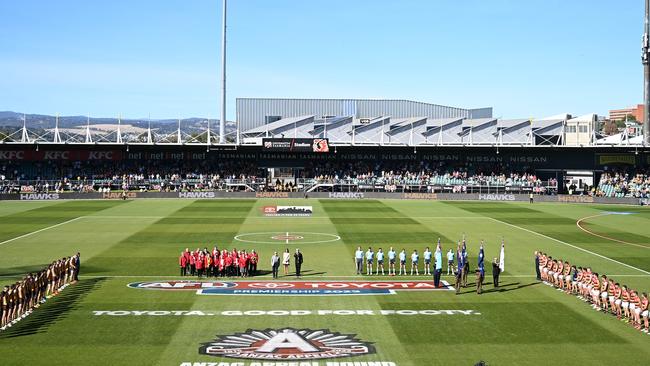
“That was a core issue but part of that reflects an age-old problem in our competition which is that people misunderstand that every competition in the world has small and large teams.
“The only issue is how you deal with them.”
By his reckoning, after crunching the numbers, the Tasmanian team would sit comfortably in the third quartile of inherent wealth in the competition. He ranks Geelong as in the second tier with clubs like Collingwood, Essendon and West Coast at the top.
“The major thing I tried to do, and it sounds a bit weird, but make this argument again that every competition has large and smaller teams so if a Tasmanian team comes in would it be like inviting Broken Hill or Wagga Wagga or Kalgoorlie into the competition.
“Or would it be like inviting Port Adelaide in. I think the argument was persuasive, with a population of 420,000 and running a set of numbers around it, it was not all that far from Port Adelaide’s share of the South Australian market.”
In August 2021, Carter delivered his report supporting the case for a 19th franchise in Tasmania although he did qualify it by saying relocating an existing team or setting up a “joint venture” with a Victorian club would be more sustainable.
For the Tasmanian Government that was the green light they craved while others hung off Carter’s relocation call which he knew wasn’t relevant anymore with North Melbourne turning around its fortunes.
“I got a text message from a journalist who is Tasmanian saying, ‘You have torn the heart out of Tasmania’ about the relocation part but I was very careful to say if that doesn’t happen, and I don’t think there is much chance of it, then a standalone Tasmanian team is viable and should be supported,” Carter said.
“Ironically that text arrived within an hour of one of the president’s from an interstate club texting me saying: “I was sceptical but you have now persuaded me”. I think the important thing was that the Commission took it seriously.”
There was no doubt it changed the narrative inside AFL House and Gutwein, who had no problem standing up to McLachlan, was on the front foot saying he wanted a decision by the end of the year or he would turn the tap off to AFL football in his state which would cost the competition millions.
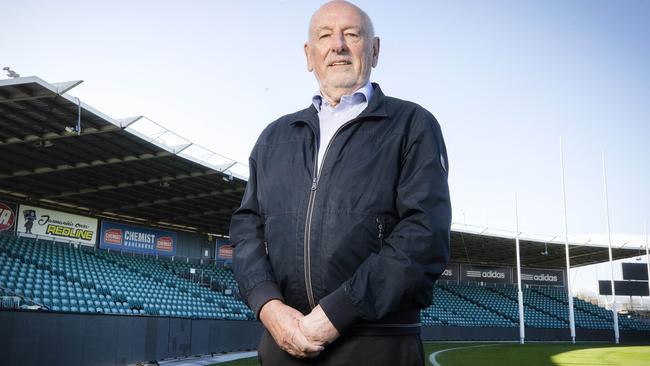
GILL POUNCES BUT WHO WILL LEAD TASSIE TEAM?
Gillon McLachlan smelt blood and went for it.
On March 1, 2022 Tasmanian Premier Peter Gutwein made a stirring speech in parliament called the ‘State of the State Address’. In it he pledged billions of dollars to be spent on housing and infrastructure all across Tasmania including a $750 million investment in a new stadium at Macquarie Point in Hobart.
McLachlan couldn’t believe his luck, now he had a bargaining tool. The stadium had been put on the table by the government and he could now position it as a no-stadium no-licence discussion.
A month later Gutwein was forced to resign over a major health issue in his family. He had been a tough negotiator and it was going to be a hard act to follow for his replacement Jeremy Rockliff.
He was perceived to lack the doggedness and authority of Gutwein and in his first meeting with McLachlan in June, the AFL chief hit him for the first time with his new play, the stadium being built was now a proviso on receiving the 19th licence.
This didn’t endear McLachlan to the Tasmanian public who were already angered about the amount of money the AFL was taking out of the state’s coffers. Even though they have longed to be a part of the national competition, the way the league has gone about it hasn’t sat well with many.
After more delays and more posturing, confirmation ahead of next month’s budget that the Federal Government is on board essentially means the team is a goer.
The numbers for the 23,000 seat stadium – which has been estimated to cost $715 million – have the state government covering $375 million, the AFL tipping in $15 million with the Albanese government $240 million and $85 million generated by the state government borrowing against the land sale or lease for commercial purposes.
A vote of the AFL presidents on the new team is expected to happen before McLachlan arrives in Hobart on Tuesday.
While the league wanted a “unanimous” verdict, that’s unlikely to happen with at least four clubs – Sydney, Port Adelaide, Collingwood and West Coast – believed to be wavering and using the vote to posture for other things from the league. A majority of the clubs is all the AFL needs.

So what will McLachlan unveil next week?
Not much. The starting date is still up in the air although 2027 has been pencilled in with the league indicating it is willing for the new franchise to play for up to two years without its new shiny stadium.
There is no-one ready to run the new club or even take the baton to start the process. The likelihood is that Tasmania’s new team will first live out of an office in Melbourne with AFL game development executive Sam Graham tipped to be the interim CEO.
A working party in the AFL, led by the league’s head of clubs and broadcasting Travis Auld, has been looking at a number of issues including the building of its inaugural list which has taken in the pros and cons of the Gold Coast Suns and GWS Giants experiences.
Veteran administrator Geoff Walsh did a report on the possible concessions for the new team – which is expected to be called the Tasmanian Devils and will wear the traditional green state jumper. That was well received by the clubs and is believed to include a focus on the new team getting access to players in the 70 to 120-game bracket in exchange for high draft picks.
The whole focus is to make Tasmania competitive in its first couple of years, a realistic finals team rather than a creche for a stack of teenagers who are finding their way.
Brisbane Lions champion Alastair Lynch, who grew up in Burnie, says the focus has to be on having a world-class training facility ready from day one.
“You have got to make people that get drafted to the Tassie side walk into a world-class facility,” Lynch said. “You can’t have temporary buildings like the Suns did in their formative years, you have to get it right from the start.”
Like many in the football world, Lynch believes current Richmond CEO Brendon Gale is the man to lead the new franchise.
“He’s a statesman of the game, he has done it on the field, done it off the field, he has got the Tasmanian heritage, he knows Tassie so he would be a perfect selection,” Lynch said.
And the coach?
Alastair Clarkson has a soft spot for the Tasmanian team given he was on the payroll as a consultant last year before taking the job with North Melbourne. He might be ready for another change of scenery in a few years time while Chris Fagan’s tenure at Brisbane might also be up by then.
“I think a Tasmanian would help but more importantly you need an iconic name,” Lynch said.
“In my day when Leigh Matthews signed on in Brisbane it was like ‘OK, I’m happy to go there now’. That’s what you need, somebody who makes people think it’s a serious football club.”
More Coverage
Originally published as Inside the rise of Tassie: Locals thought Gillon McLachlan wanted to move Roos, but now 19th team a reality




